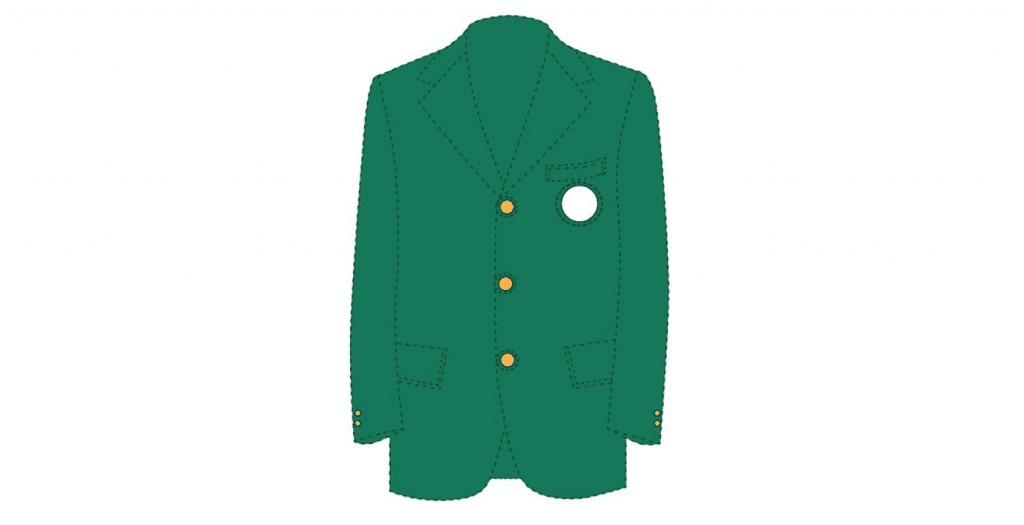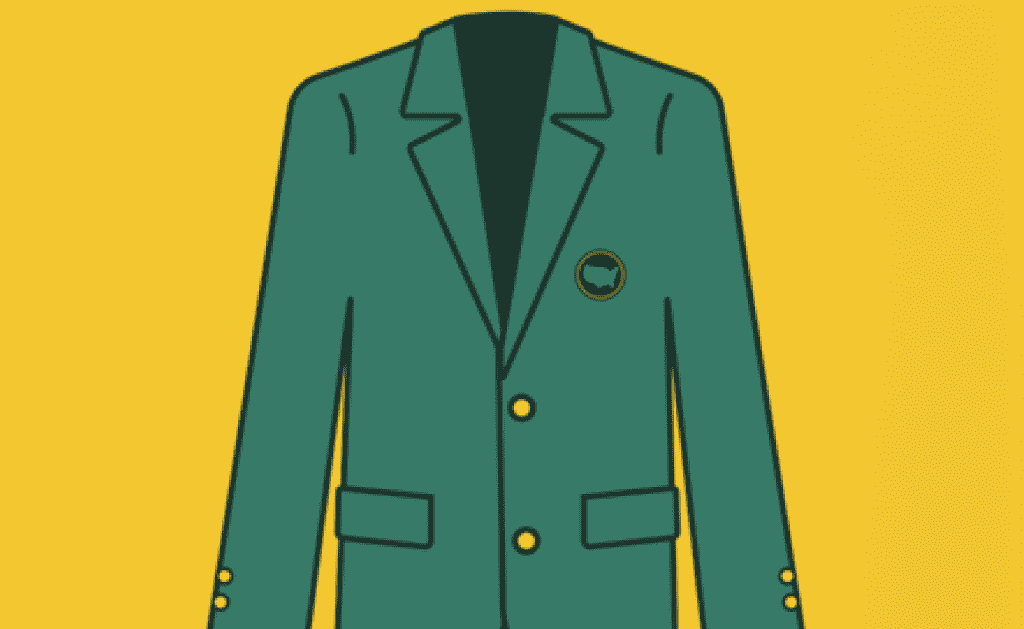Every year since 1949, in addition to the medallion or trophy that the winner of the Masters Tournament is handed after completing 18 holes at the pink azalea-flush and signature shrub-lined Augusta National Golf Club, he is presented with an even more significant prize: a green jacket. The jacket, which comes in a very specific shade of green – Pantone 342, represents the championship winner’s status as an honorary member of one of the most exclusive golf clubs in the world.
Between the time that the Masters winner on any given year gets his jacket (he goes home on the winning day without one and a custom one is sent to him shortly thereafter), and the tournament the following year, he can wear it whenever and wherever he wants. 2010 Masters champ Phil Mickelson famously wore his to an Augusta Krispy Kreme donut shop the day after the tournament, while Sergio Garcia wore his to watch Rafael Nadal play at Wimbledon a few months after he won in 2017. After that year or so period is up, the rules change. As of the time of the next year’s Masters, the winner has to return the jacket to the invitation-only club, where it then will to live (and can be worn), since the green jacket is only allowed to be worn off the grounds of Augusta National for that one-year period of time.
That is one of the “rigid standards” that come with the jacket, according to Augusta National, Inc., along with the rule that the jacket “cannot be sold or given to third parties under any circumstances and, to ensure authenticity, each Green Jacket is marked for identification.”
Easily one of the most famous indictors of stature in the world of golf, the Masters jacket – or better yet, the colors green and gold when used on the Masters jacket – has taken on meaning outside of the sport, something like how people who are not die-hard hockey fans may know the name or the shape of the National Hockey League’s distinctive Stanley Cup. This connection that the general public makes between the Green Jacket and the Masters tournament is precisely why Augusta National, Inc. landed a win of its own last month when the U.S. Patent and Trademark Office (“USPTO”) agreed to register the colors of the jacket as a trademark after initially refusing to do so earlier last year.

Despite maintaining an arsenal of trademark registrations for everything from word marks like “Masters,” “Augusta National Golf Club,” and “Green Jacket” (including for use on jackets) to the “configuration of a golf hole” (i.e., the landscape design and layout of one if its actual golf course holes, complete with the placement of various trees, grass, and shrubbery), Augusta National, Inc. did not have a registration related the actual jacket, itself, for nearly the entire time the tournament – and the jacket – existed.
That started to change early last year when counsel for Augusta National, Inc. filed a trademark application with the USPTO seeking a registration for “the colors green and gold where the color green is applied to the jacket and the color gold is applied to the three waist buttons and the two sleeve buttons on each arm of the jacket.” According to the application, Augusta National was not actually seeking exclusive rights in the jacket design; in fact, it did not list class 25, the trademark class that includes garments, on the application. Instead, it claimed exclusive rights in the mark in connection with the “promotion of goods and services through sponsorship of sports events,” and “organizing and conducting golf tournaments.”
In a formal response to Augusta National’s application, dated April 12, 2019, an examining attorney for the USPTO preliminarily refused to approve the application, asserting that, among other things, the jacket is a “Non-Distinctive Product Design” that is “not registrable on the Principal Register without sufficient proof of acquired distinctiveness.” This meant that in order for the mark to be eligible for registration, Augusta National would need to show that the jacket had secondary meaning in the minds of consumers. In other words, when consumers see the jacket, they link it with a single source.
In order to do that, trademark applicants typically submit evidence of “advertising expenditures, sales success, length and exclusivity of use, unsolicited media coverage, and consumer studies (linking the [trademark] to a source),” and that is precisely what Augusta National, Inc. did. Counsel for the club’s corporate entity filed a 277 page response in November 2019, in which it argued that its Green Jacket trade dress – “one of the most recognized brands in the golf industry” – has acquired distinctiveness “based on its extensive use of the mark identifying [Augusta National, Inc.] as the source of the Masters golf tournament for over seventy (70) years, as well as extensive third-party coverage and consumer recognition of the mark in connection with the relevant services.”
Augusta National, Inc. supplemented its argument with more than 200 pages of examples of articles that depict or mention the Green Jacket, and asserted that the “Green Jacket has been the answer to, or part of a question on, Jeopardy at least nine times, and is used on the cover of the PS3 and XBox golf game featuring Augusta National.” Finally, it also noted that “a simple Google internet search of the words ‘green jacket’ reveals an entire first page of articles and other references to [Augusta National, Inc.] and its Masters Tournament clearly demonstrating that the primary significance of the Green Jacket trade dress to consumers is [Augusta National, Inc.] and its famous Masters Tournament.”
Seemingly satisfied, the USPTO agreed to allow the application to move forward in the registration process, and issued a registration to Augusta National, Inc. for its specific use of the colors in connection with the jacket in March 2020.
As for the rule that famous jacket “cannot be sold or given to third parties under any circumstances.” There is one notable exception: relatives of Horton Smith, who won the tournament in 1934 and 1936, found his green jacket in a closet in 2013, and put it up for auction that year. It sold for $682,229. And even more recently, the rule and a Masters jacket found themselves at the center of a lawsuit when Augusta National, Inc. filed suit against Florida-based Green Jacket Auctions Inc to prevent the unaffiliated organization from selling an array of Augusta Nation-branded wares, including a champion’s green jacket (the champion’s green jacket won by Byron Nelson in 1966, which had gone missing from the club), and two member jackets.
Augusta National, Inc. argued that Green Jacket Auctions was in “wrongful possession” of and lacked legal title in all three jackets, and the parties ultimately settled the case in early 2019. As for Nelson’s jacket, that has remained in the possession of Gregory Waunford-Brown, who, according to court documents, acquired the jacket privately through Green Jacket Auctions.











